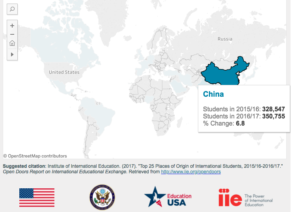According to the Institute of International Education, China students lead international enrollment in the U.S.
The U.S. is widely known for its international student enrollment.
From many parts of the world, youth from China, Mexico, India and more seek for a place in American schools as they contribute up to 542 billion dollars in revenue for the education industry.
As for the 2016/2017 academic year, there were 350,755 Chinese students enrolled in American schools, according to the Institute of International Education (IIE).
- 186,267 students where from India
- 58,663 from South Korea
- 52,611 from Saudi Arabia
- 27,065 from Canada
Following the top five on the chart were:
- Vietnam (22,438)
- Taiwan (21,516)
- Japan (18,780)
- Mexico (16,835)
- Brazil (13,089)
According to Statista, in the 2016/17 academic year, there were over 391,124 international graduate students which accounted for almost half the international students in the U.S., while business and management programs and engineering were among the most common fields of study for these students.
Home of international studies, high tuition fees, and migrants
Even though the U.S. might seem like a great place to enroll for an education, it pays some of the highest tuition fees in the world.
As for the top-city economic contributors where non-born U.S. graduates reside or acquired a degree during the past years, according to USNews, were New York, California, Massachusetts, Texas and Pennsylvania.
The University of Washington, Michigan, Ohio and Florida are the universities with the highest number of foreign students in the U.S.
It is estimated that every year, a 4% growth will be seen in the number of international students across U.S. cities, as 760,000 alumni existed between 2011 and 2012, while over one million were counted in 2015-2016.
The U.S. is still home to the majority of international migrants worldwide. Just in 2017, there were a total of 258 million international migrants in the world, and according to the most recent “International Migration Report” of the United Nations (UN), the U.S. was home to 49.8 million of them.













